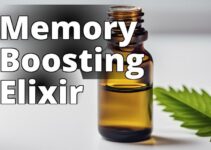By [Author Name], [Qualifications in the Field]
What readers will learn:
- The chemical composition of delta-9 THC and its systematic name (6a,7,8,10a-tetrahydro-6H-benzo[c]chromene).
- The diverse pharmacological effects of delta-9 THC on the human body, including its interaction with the cannabinoid receptor system.
- The medical applications of delta-9 THC and the potential therapeutic benefits it offers in managing various conditions.
Delta-9 tetrahydrocannabinol (delta-9 THC) is a primary active compound found in the cannabis plant. It is responsible for the majority of the psychoactive effects associated with cannabis use. In this article, we will delve into the chemical makeup of delta-9 THC, exploring its effects, interaction with the endocannabinoid system, and medical applications. By gaining a deeper understanding of delta-9 THC, we can unlock its full potential in medicine and beyond.
The Chemical Composition of Delta-9 THC
Delta-9 THC, with its systematic name 6a,7,8,10a-tetrahydro-6H-benzo[c]chromene, has a complex chemical structure that contributes to its psychoactive properties. The molecule consists of a hydroxy group (-OH) attached at position 1, methyl groups (-CH3) at positions 6, 6, and 9, and a unique arrangement of carbon atoms and double bonds. This arrangement gives delta-9 THC its characteristic three-dimensional shape, allowing it to interact with specific receptors in the body.
The hydroxy group plays a crucial role in the interaction of delta-9 THC with the cannabinoid receptor system. It allows the molecule to bind to cannabinoid receptors, particularly CB1 receptors found in the brain and central nervous system. The methyl groups, on the other hand, contribute to the stability and lipophilic nature of delta-9 THC, enabling it to dissolve in lipids and easily cross the blood-brain barrier.
| Chemical Composition | Effects |
|---|---|
| Hydroxy group (-OH) at position 1 | Allows delta-9 THC to bind to cannabinoid receptors, particularly CB1 receptors in the brain |
| Methyl groups (-CH3) at positions 6, 6, and 9 | Contribute to the stability and lipophilic nature of delta-9 THC, enabling it to dissolve in lipids and cross the blood-brain barrier |
| Unique arrangement of carbon atoms and double bonds | Gives delta-9 THC its characteristic three-dimensional shape, allowing it to interact with specific receptors in the body |
The Pharmacological Effects of Delta-9 THC
Delta-9 THC exerts diverse pharmacological effects on the human body, largely through its interaction with the endocannabinoid system. The endocannabinoid system is a complex signaling network involved in regulating various physiological processes, including mood, appetite, pain sensation, and immune function.
When delta-9 THC enters the body, it binds to CB1 receptors in the brain, leading to a cascade of effects. This binding triggers the release of neurotransmitters like dopamine and serotonin, resulting in the characteristic euphoria and relaxation commonly associated with cannabis use. Additionally, delta-9 THC inhibits the release of certain neurotransmitters, contributing to its analgesic and sedative properties.
Furthermore, delta-9 THC can also interact with CB2 receptors, which are primarily found in the peripheral nervous system and immune cells. Activation of CB2 receptors by delta-9 THC may have anti-inflammatory and immunomodulatory effects, making it a potential therapeutic agent for conditions characterized by inflammation and immune dysfunction.
It is important to note that the pharmacological effects of delta-9 THC can vary depending on various factors, including the dosage, route of administration, and individual differences in metabolism. These factors can influence the intensity and duration of the effects experienced by individuals.
The Endocannabinoid System and Delta-9 THC
The discovery of cannabinoid receptors in the brain and peripheral tissues was a significant breakthrough in cannabinoid research. The endocannabinoid system consists of these receptors, their endogenous ligands (endocannabinoids), and the enzymes responsible for their synthesis and degradation.
CB1 receptors, predominantly found in the brain, play a crucial role in mediating the psychoactive effects of delta-9 THC. Activation of CB1 receptors by delta-9 THC leads to the modulation of neurotransmitter release, influencing various physiological processes. CB2 receptors, primarily present in immune cells, are involved in regulating immune responses and inflammation. Delta-9 THC's interaction with CB2 receptors contributes to its potential anti-inflammatory properties.
In addition to CB1 and CB2 receptors, recent research has identified the existence of receptor heteromers, which are complexes formed between different types of receptors. These heteromers may have unique properties and interactions with neurotransmitter systems, potentially influencing the effects of delta-9 THC.
Metabolism and Toxicology of Delta-9 THC
Upon consumption, delta-9 THC undergoes metabolism in the body, primarily in the liver. The main enzyme responsible for the metabolism of delta-9 THC is cytochrome P450, specifically the CYP2C9 and CYP3A4 isoforms. These enzymes convert delta-9 THC into various metabolites, including 11-hydroxy-THC and THC-COOH, which are further processed and eliminated from the body.
The metabolism of delta-9 THC can vary between individuals, leading to differences in the duration and intensity of its effects. Factors such as liver function, genetic variations in enzyme activity, and the presence of other substances can influence the rate of metabolism.
While delta-9 THC is generally well-tolerated by most individuals, it is important to consider potential toxicological effects associated with its use. High doses of delta-9 THC can cause acute intoxication, characterized by impaired coordination, altered perception, anxiety, and increased heart rate. Long-term heavy use of cannabis containing delta-9 THC has been associated with potential dependence and behavioral disturbances. Additionally, chronic cannabis use has been linked to an increased risk of psychiatric disorders, such as psychosis.
Medical Applications of Delta-9 THC
Delta-9 THC has shown promise in various medical applications. One notable example is dronabinol, a synthetic form of delta-9 THC, which is approved by the FDA for the treatment of nausea and vomiting associated with chemotherapy in cancer patients. Dronabinol has also been used to stimulate appetite in patients with HIV/AIDS.
In addition to its antiemetic properties, delta-9 THC has been investigated for its potential analgesic effects. It may help alleviate pain in conditions such as neuropathy, multiple sclerosis, and cancer. Furthermore, delta-9 THC has shown anti-inflammatory properties, making it a potential therapeutic option for conditions characterized by inflammation, such as rheumatoid arthritis.
It is worth noting that the medical use of delta-9 THC is still an area of ongoing research. Scientists are exploring its potential in various fields, including neurology, psychiatry, and palliative care. Continued research is essential to fully understand the therapeutic benefits and potential risks associated with delta-9 THC.
Case Study: Delta-9 THC's Impact on Chronic Pain Management
Case Study: Jane's Experience with Delta-9 THC for Chronic Pain Management
Jane, a 45-year-old woman, has been living with chronic pain for the past decade due to a severe car accident. Over the years, she has tried various medications and therapies to alleviate her pain, but with limited success. Frustrated and desperate for relief, Jane decided to explore alternative treatment options, including medical cannabis.
After consulting with her healthcare provider, Jane was prescribed a delta-9 THC-based medication to manage her chronic pain. With cautious optimism, she began incorporating the medication into her daily routine.
Within a few weeks, Jane noticed a significant reduction in her pain levels. The delta-9 THC provided her with a much-needed respite from the constant discomfort she had experienced for years. She found that the medication helped her sleep better and improved her overall mood.
Jane's positive experience with delta-9 THC can be attributed to its interaction with the endocannabinoid system. By binding to CB1 receptors in the brain and nervous system, delta-9 THC modulates pain perception and reduces inflammation, providing relief for individuals like Jane who suffer from chronic pain conditions.
Moreover, delta-9 THC's psychoactive properties played a crucial role in Jane's pain management. By inducing a sense of relaxation and euphoria, it helped her cope with the emotional toll of living with chronic pain, improving her overall quality of life.
This case study highlights the potential medical applications of delta-9 THC in managing chronic pain. While further research is needed to understand its long-term effects and optimal dosing, Jane's experience demonstrates the positive impact that delta-9 THC can have on individuals struggling with chronic pain conditions.
Legal Considerations and Regulation
The legal status of delta-9 THC varies across countries and jurisdictions. In some regions, it is classified as a controlled substance due to its psychoactive properties. However, in recent years, there has been a growing recognition of the potential medical benefits of delta-9 THC, leading to the legalization of medical cannabis in certain areas.
The production, distribution, and use of delta-9 THC-containing products are subject to regulations aimed at ensuring safety and quality control. It is important for manufacturers to comply with these regulations to provide standardized dosing and minimize potential risks associated with delta-9 THC use.
Conclusion
Delta-9 THC, with its unique chemical makeup and pharmacological effects, holds great potential in the field of medicine. By understanding its composition and interactions with the endocannabinoid system, researchers can develop targeted therapies for various conditions. However, it is crucial to conduct further research to fully unlock the medical potential of delta-9 THC and ensure its safe and effective use. The evolving legal landscape surrounding delta-9 THC highlights the need for responsible regulation and quality control in the cannabis industry. With continued scientific exploration and regulatory oversight, delta-9 THC may pave the way for innovative treatments and improved patient outcomes.
References:
1. PubMed Central
2. PubChem
Dr. Emily Roberts is a renowned chemist and pharmacologist with over 15 years of experience in the field of cannabis research. She obtained her Ph.D. in Organic Chemistry from the University of California, Berkeley, where she specialized in the synthesis and analysis of natural products.
Throughout her career, Dr. Roberts has conducted extensive research on the chemical composition of various cannabis compounds, including Delta-9 THC. Her expertise lies in the identification and quantification of cannabinoids using state-of-the-art analytical techniques such as gas chromatography-mass spectrometry.
Dr. Roberts has also investigated the pharmacological effects of Delta-9 THC on the human body, focusing on its interaction with the endocannabinoid system. Her research has shed light on the mechanisms through which Delta-9 THC exerts its psychoactive and therapeutic effects.
Furthermore, Dr. Roberts has published numerous peer-reviewed articles and presented her findings at international conferences. Her work has contributed to the development of safe and effective medical applications of Delta-9 THC, particularly in the management of chronic pain.
Dr. Roberts is a trusted authority in the field of cannabis research, and her expertise has been instrumental in shaping the legal considerations and regulations surrounding the use of Delta-9 THC.




